
SEO Topic Clusters: Complete Guide, Examples & Free Templates
In content marketing, content should never exist in silos.
When it does, it becomes harder to organize your site, build internal links, and scale content effectively. You risk creating duplicate content, and search engines also struggle to recognize your authority across a topic.
At Moz, I’ve helped build product-led topic clusters that solve these issues. Creating topic clusters helps us rank for broader topics, increase conversions, and drive consistent organic traffic without creating more content than we need.
In this guide, I’ll show you how to build topic clusters from scratch. You’ll get templates, workflows, and a repeatable process you can use to build topical authority that lasts.
What are topic clusters?
Topic clusters are a content strategy framework that helps you organize your content by topic rather than individual keywords. Instead of publishing disconnected blog posts, you group related content together and link it to a central resource.
This organization helps users navigate your content and improves your rankings in search engine results.
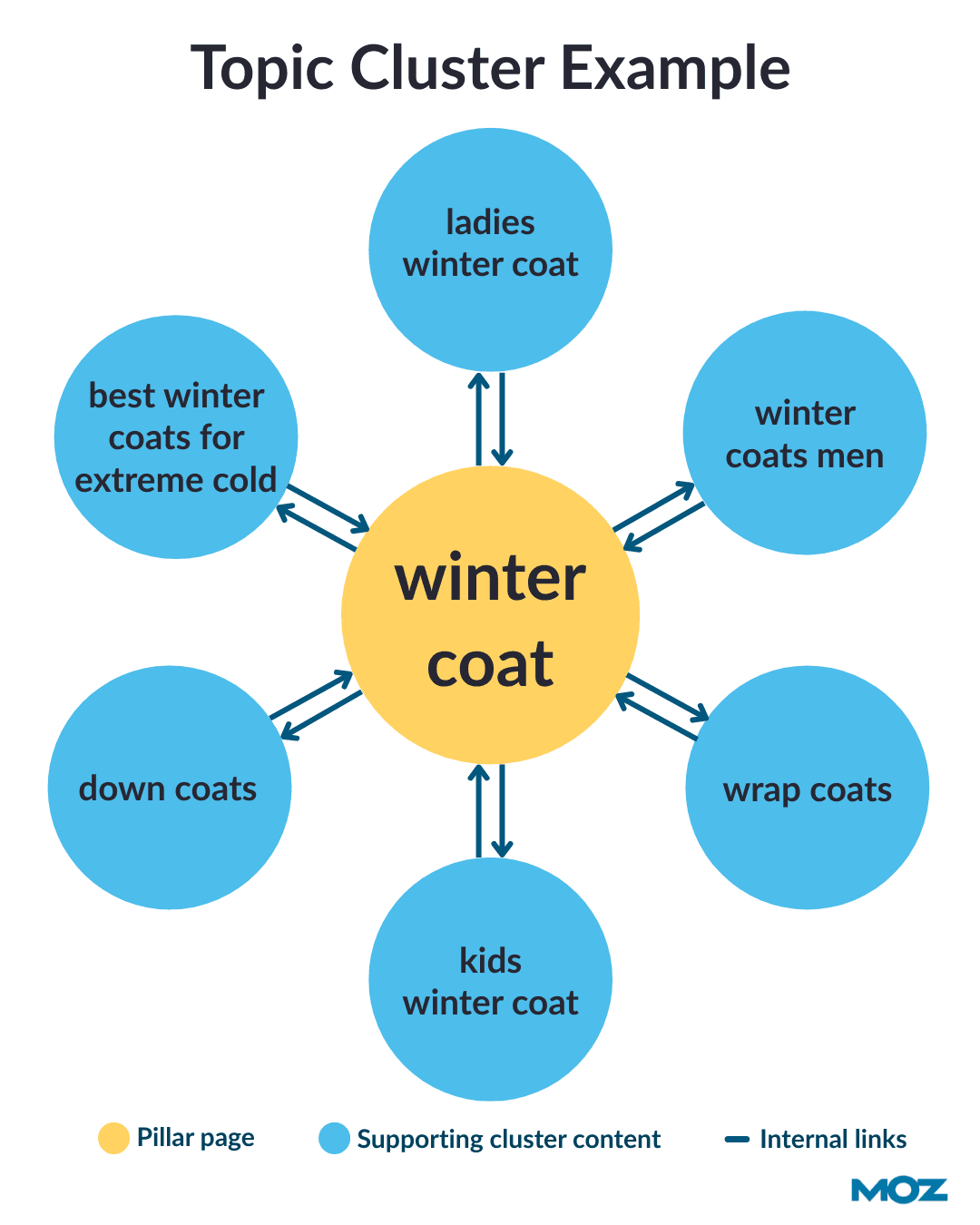
Here are the core components of a topic cluster model:
Pillar page
The pillar page is the main page that covers your primary topic in depth. It’s usually a long-form guide that targets a broad keyword with a high monthly search volume.
Supporting cluster content
These are individual pages that cover subtopics related to the pillar. Each one targets a specific search intent and links back to the pillar.
For example, if we use the topic of “winter coat” as our hub, subtopics might include:
- Ladies winter coat
- Kids winter coat
- Winter coats men
- Best winter jackets for extreme cold
- Wrap coats
Internal linking model
Internal links connect the topic cluster. Each supporting piece links to the pillar (and ideally, the pillar links back), creating a clear content hierarchy.
Why are topic clusters important for SEO?
Topic clusters help search engines and users understand how your content connects. Instead of treating each blog post as a standalone asset, clusters turn your content into a system that improves rankings, strengthens authority, and supports conversions.
Here’s how topic clusters impact your SEO performance:
Establish topical authority by ranking for all related keywords
Topic clusters help you rank for multiple variations of a topic. You focus your pillar on a broad keyword and use supporting pages to target thematically related keywords and thoroughly address a specific topic.
A layered approach increases your chances of ranking for different search intents and ensures your content shows up across the user journey.
Improve internal linking structure
Internal links in a topic cluster follow a clear logic: pillar links to cluster, and cluster links to pillar.
These links:
- Distribute link equity across your cluster and
- Help visitors find what they need faster
- Make it easy for search engines to understand their relationship
Avoid keyword cannibalization
Keyword cannibalization happens when multiple pages compete for the same keyword. It often happens when you publish multiple pages with similar search intent, which weakens your ability to rank.
Topic clustering prevents cannibalization by grouping keywords into topics. SEO tools like Moz Keyword Explorer use AI to cluster topics, ensuring you create only as much cluster content as you need.
Cluster content by intent to prevent keyword cannibalization

How to build a topic cluster
For this section, feel free to grab these resources to help you create a topic cluster and associated subtopics :
Choose a pillar topic
Your pillar topic is the foundation of your topic cluster and the basis for your pillar page content. It should be broad enough to support several subtopics, but specific enough to tie directly to your product or service.
When picking a pillar, look for three things:
- Enough search volume to support related subtopics
- A direct link to a problem your product solves
- Clear opportunities to link to product or feature pages
Let’s take “CRM” as a topic cluster example.
For SaaS brands in this space, CRM is product-led and has strong search demand. In Moz Keyword Explorer, “CRM” shows 84,000 monthly searches, a Keyword Difficulty of 74, and a minimum Domain Authority of 54 in the top 10 results.
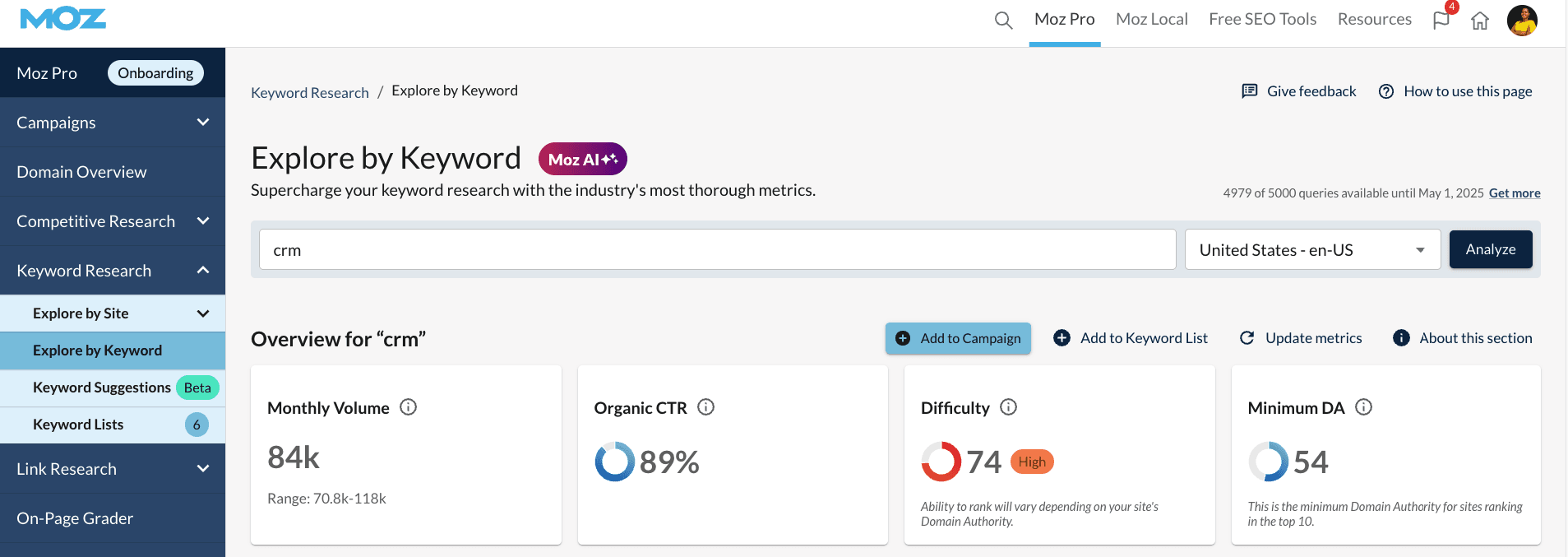
If you’re optimizing a new website, the odds are stacked against you, and you’d be better off targeting a keyword with a lower difficulty.
We've just launched a new feature for Moz Pro called Keyword Suggestions by Topic. It's powered by Moz AI and speeds up your keyword research by helping you quickly identify high-impact topic clusters.
In Keyword Suggestions by Topic, you’ll find smaller, more accessible pillar ideas inside the Topic Tree Map.
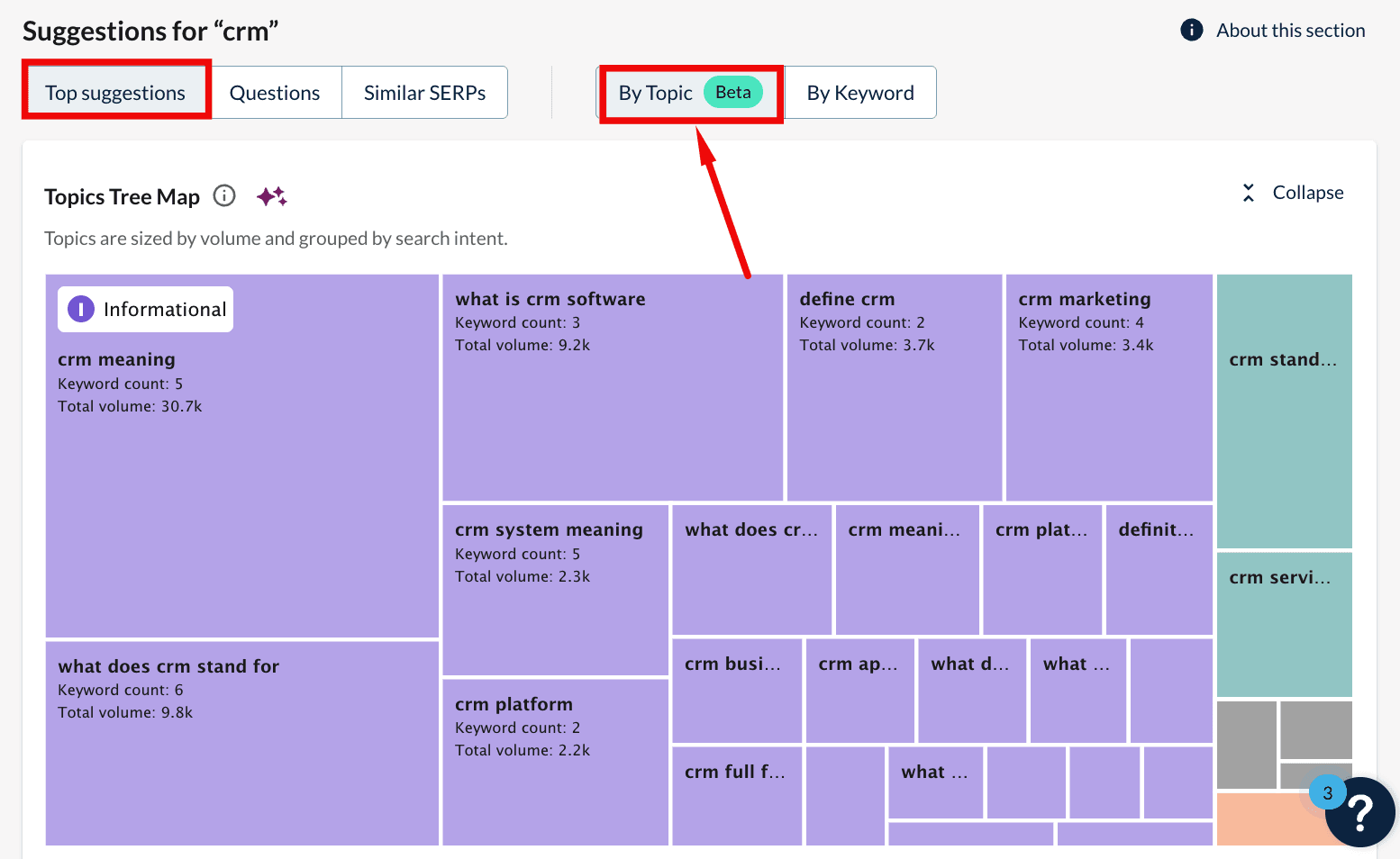
Filter by Keyword Difficulty to surface options with better odds and filter from low to high.
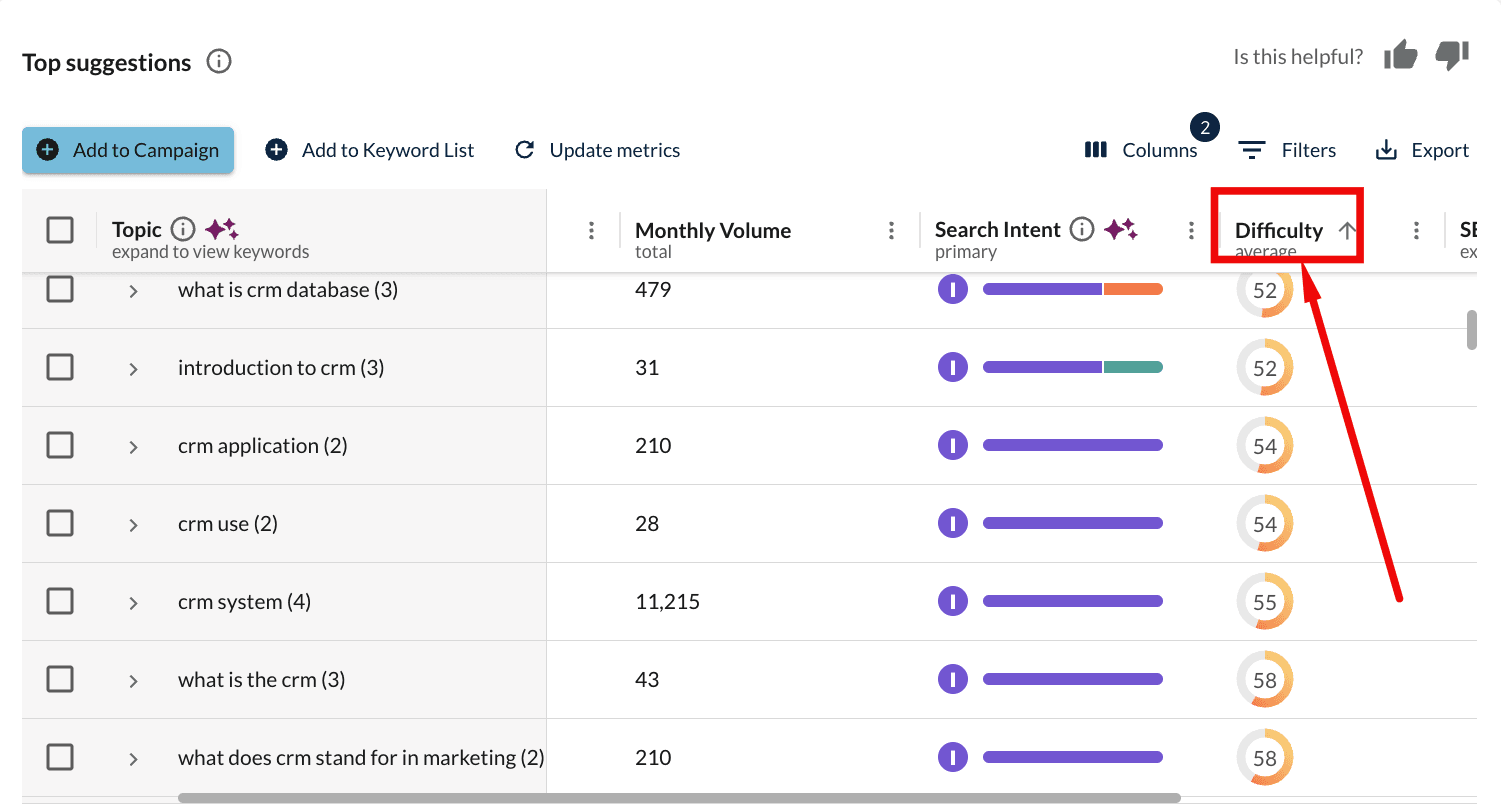
For instance, “CRM system” shows 11,215 total monthly searches.
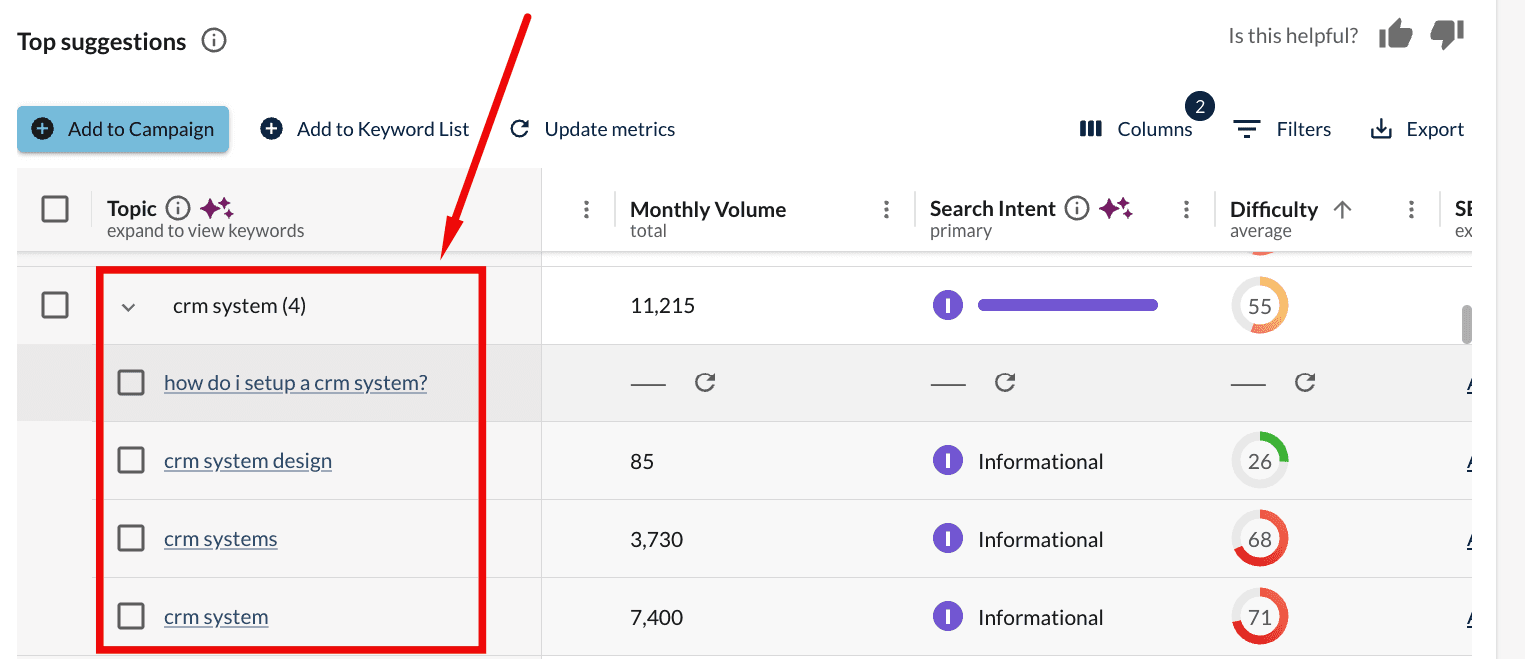
When I clicked the keyword to find related topics for the cluster, it generated some interesting results.
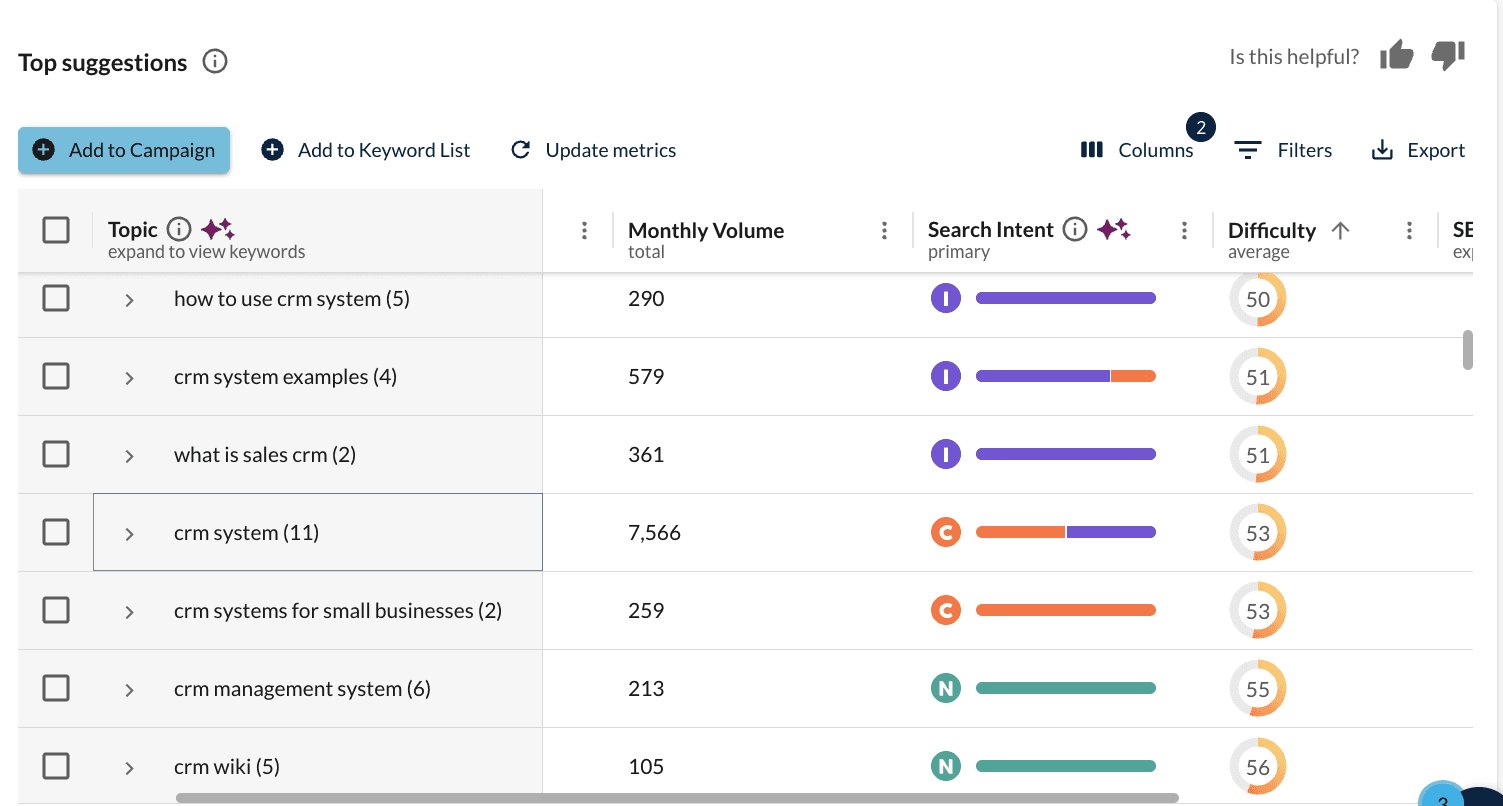
Here’s what my topic cluster would look like:
Pillar page
CRM system
Subtopics
- How to use CRM system
- CRM systems for small businesses
- CRM management system
Start with the subtopics that have a lower search volume. I’ve seen better results when cluster pages rank first. They build momentum and authority before the pillar goes live. If you publish the pillar first, it often ends up competing with your supporting content.
Once you’ve built the first topic cluster, repeat the process and keep expanding until you’ve covered the topic completely.
If you’re a larger brand or have the budget to move faster, start with a mid-competition keyword and work your way up. A phased approach lets you rank early for adjacent topics, and then scale into higher-volume terms over time.
Cluster your keywords automatically
with Keyword Suggestions by Topic

Conduct a content audit for the topic
Before you create new content for your topic cluster, review what you already have. A content audit helps you identify which pages can support your SEO topic cluster, what needs updating, and where the gaps are.
Here’s how to do it:
Run a content inventory
Start by exporting your content data from Google Search Console.
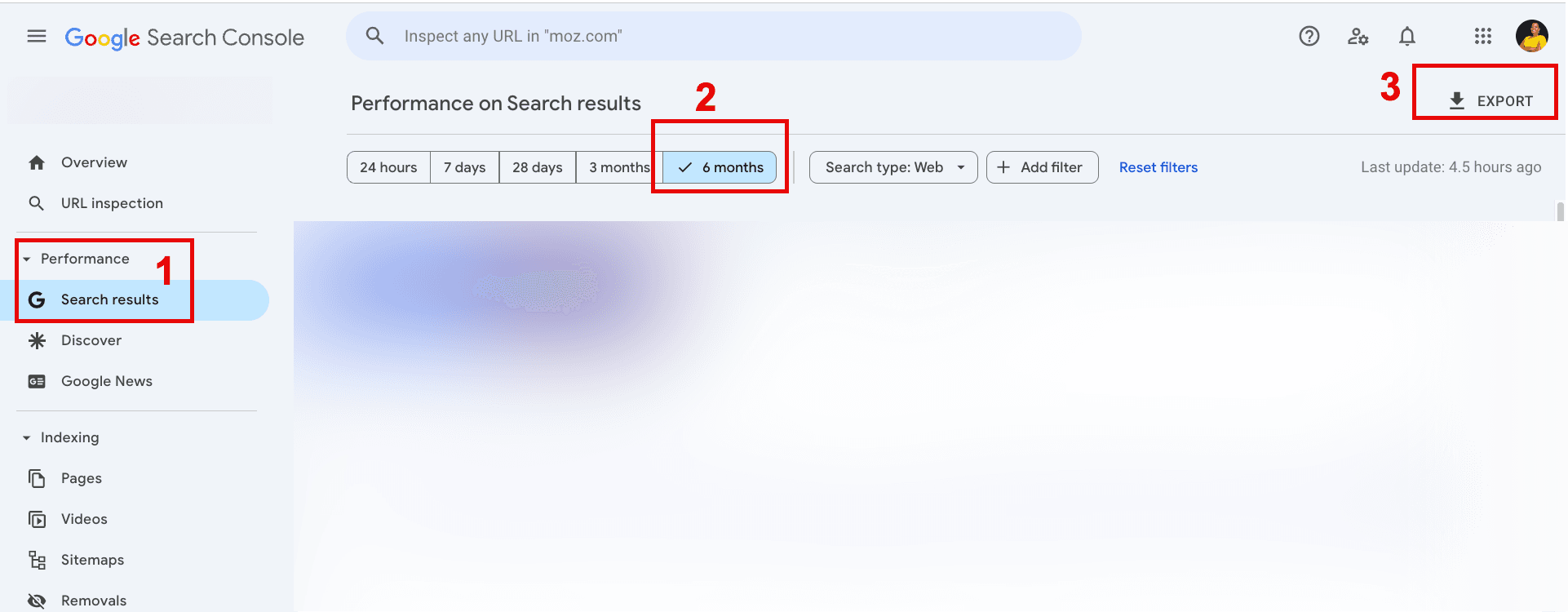
- Go to Performance → Search Results
- Set the date range to 6 months
- Click Export
In your spreadsheet, use Ctrl + F to filter the list by topic and find pages related to your chosen pillar. Then copy those URLs into your topic cluster template.
If you're using Google Sheets, you can also pull in metrics like clicks and impressions.
For deeper analysis, combine Moz API with Google Colab to run a bulk crawl of your URLs and pull:
- Page title
- URL
- Page Authority
- Monthly search volume
- Keyword Difficulty
- Primary and secondary keywords
This workflow helps you centralize everything and simplifies the process of integrating old content into your topic cluster.
Analyze the performance of existing content
Once you have data for your existing URLs, check for:
- Traffic in the last 90 days
- Primary keywords
- Best current position
- Page Authority (PA)
You’re creating a hierarchy where your pillar page is at the top and supporting content is organized by performance.
Identify content gaps
Once you’ve organized your content, you’ll start to see what’s missing or underperforming.
Common gaps include:
- Missing subtopics
- Cannibalized content
- Outdated or thin articles
- Pages with no internal links to the pillar
- Pages that don’t match search intent
Decide on action steps
For each page, use your performance data to make a call:
- Update outdated content or pages slipping from page one
- Consolidate low-performing or overlapping posts
- Redirect irrelevant or outdated pages that can't be salvaged
- Leave quality content that’s already performing well and aligned with the cluster
Do keyword research and gap analysis to discover new topics
Once you’ve audited your existing content, it’s time to expand your topic cluster. Keyword research is the best method, and I recommend approaching this from two angles:
- Use keyword suggestions grouped by topic
- Run keyword gap analysis on your competitors
Both methods reveal related subtopics, match content to intent, and help you build topic clusters that rank higher in search engine results pages.
Find keyword suggestions by topic
If you already know your pillar topic, start by exploring related keywords grouped by theme. Let’s use "wood flooring" as an example.
Moz’s Keyword Suggestions by Topic does the heavy lifting. It automatically organizes keywords into topic-based clusters so you can see what to cover and how to group your content.
Here’s how to do it:
- Enter your keyword in Explore by Keyword

- Use the Topic Tree Map to view clusters grouped by intent and sized by monthly search volume
- Hover over a box to view the total volume, number of keywords, and sample terms
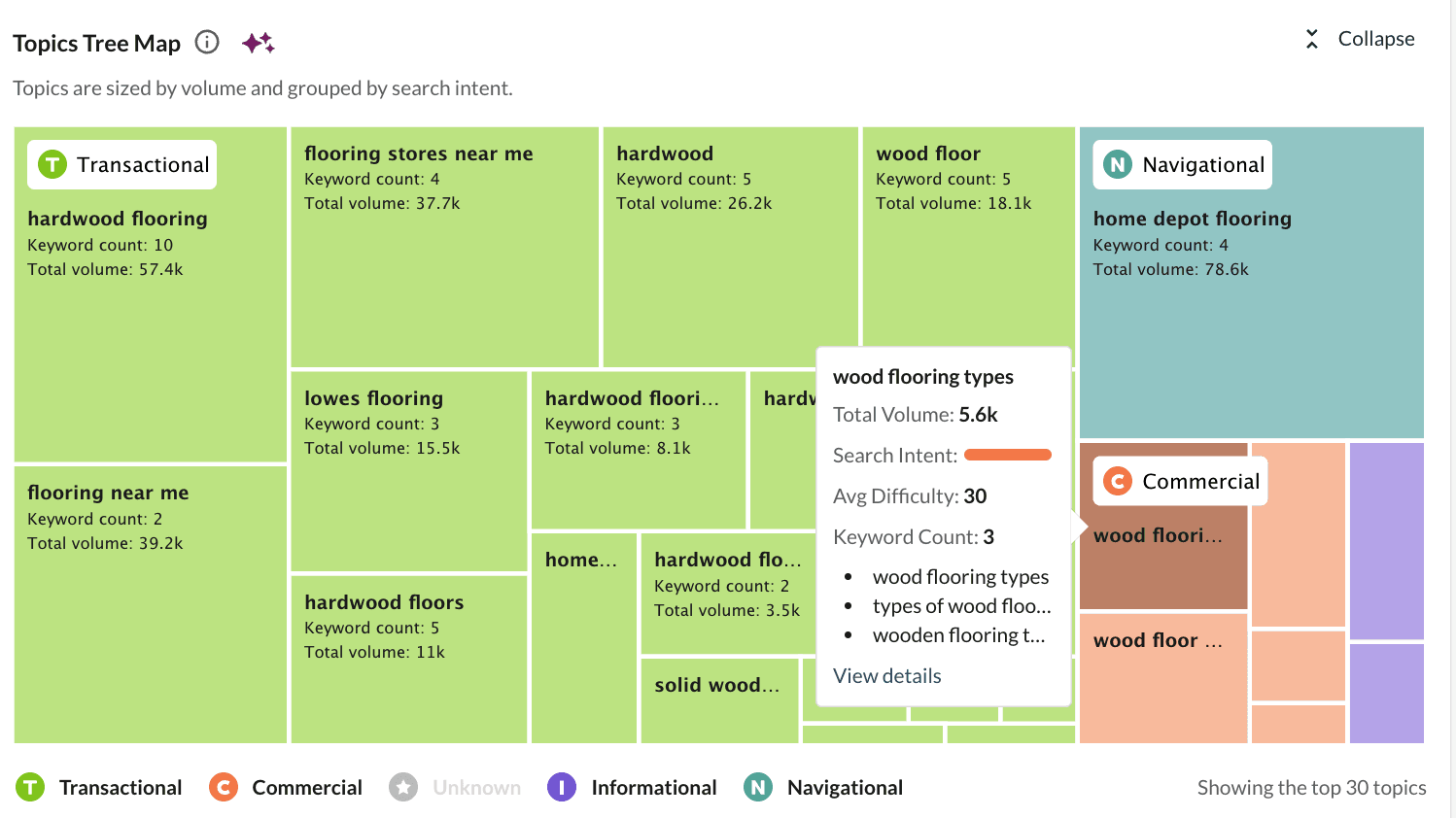
- Scroll to Keyword Suggestions to see relevant keywords filtered by search volume
- Use filters to surface bottom and middle-of-funnel keywords using modifiers like “best,” “for,” “vs,” and “how”
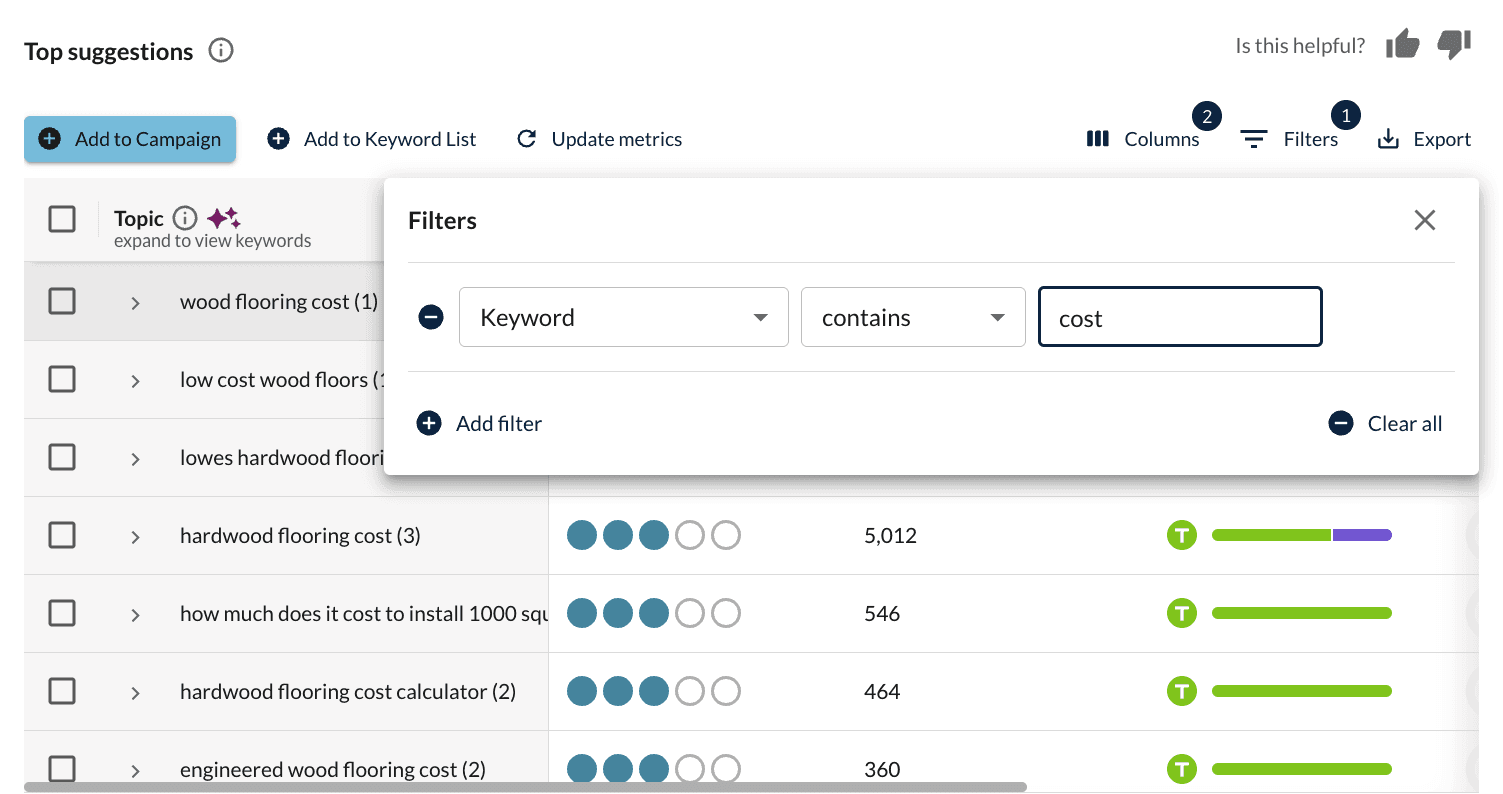
Here are more modifiers to filter your keyword research results.

Use keyword gap analysis to uncover competitive opportunities
The second method is spying on your competitors to find what you’re missing.
Moz’s Keyword Gap tool helps you identify:
- Keywords your competitors rank for, and you don’t
- Keywords where you rank lower, but could easily improve
- Opportunities to expand or protect your rankings
How to use it:
Choose a high-volume keyword in your topic cluster and analyze the SERPs to find your top competitors.
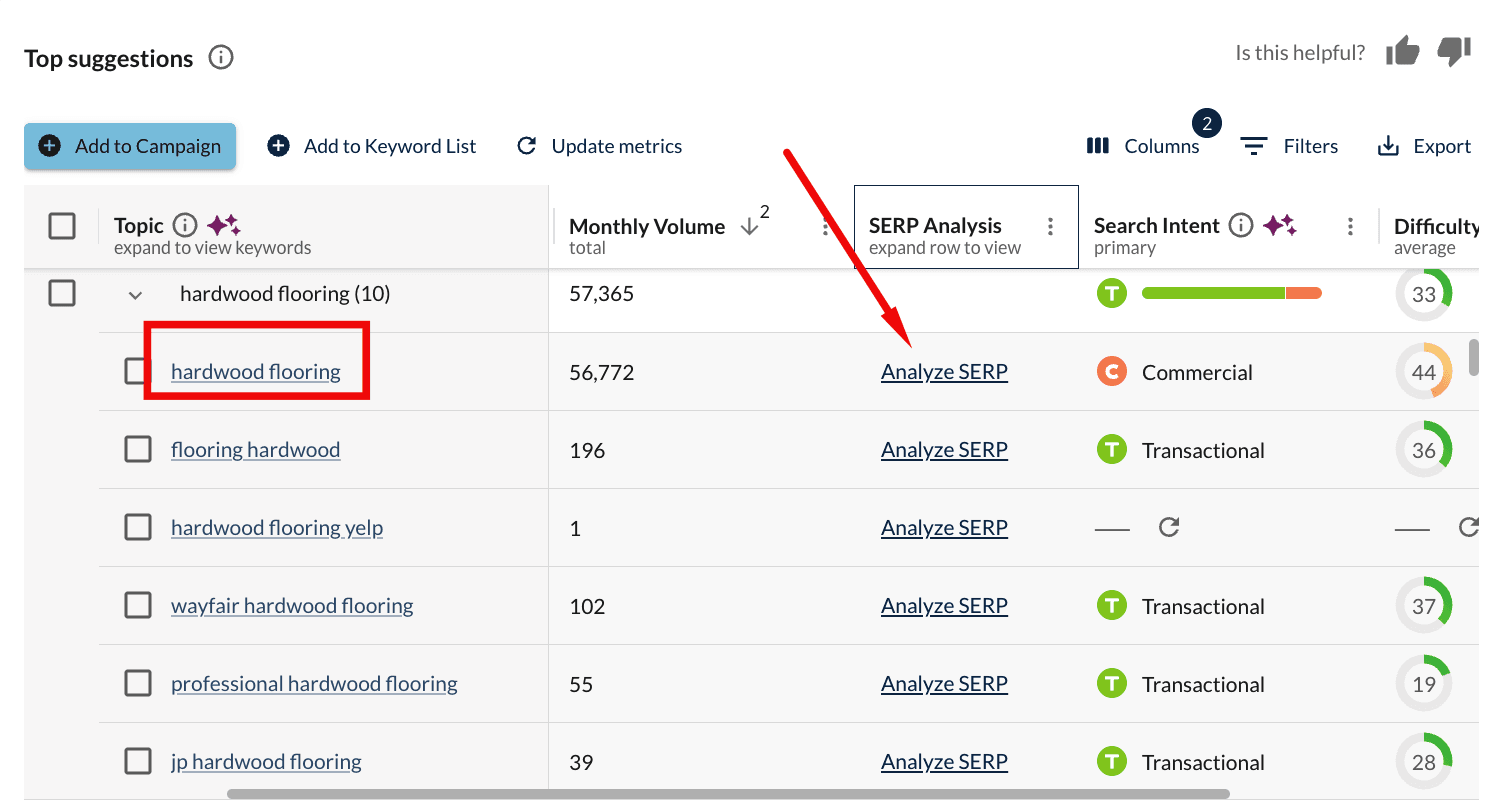
In this example, let’s say Empire Today is your site, and Home Depot, Floor and Decor, and Lowe’s are the competitors.
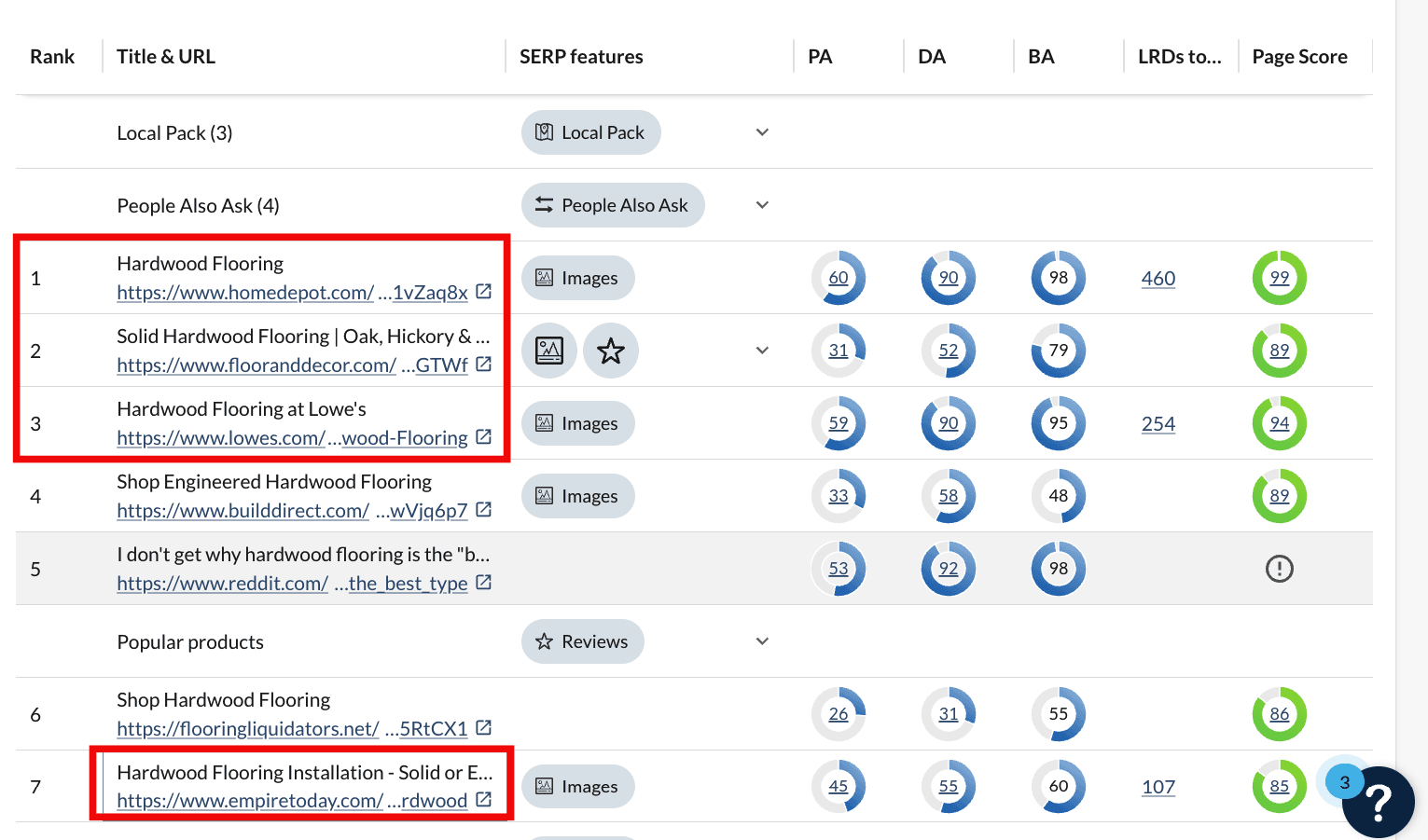
Go to Keyword Gap, enter your domain (or subfolder for deeper analysis), and add up to three competitors. Next, select your market and click Analyze
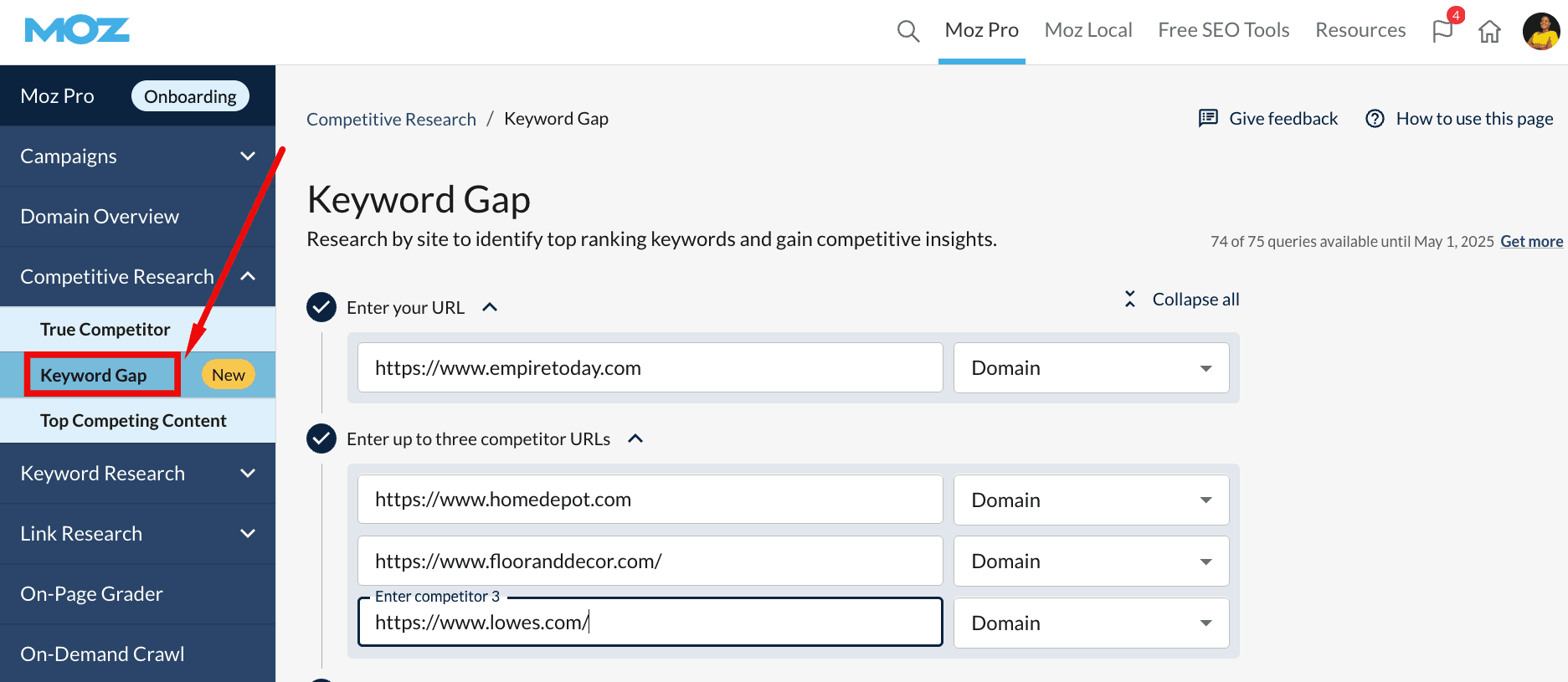
Scroll down to view:
- Keywords to improve: You rank in positions 2–20
- Traffic lift: The traffic you could gain by moving up in rankings
- New opportunities: Keywords your competitors rank for and you don’t
- Winning keywords: Terms you already dominate and should protect
I usually start with keywords to improve since those require less effort. Then I add new, relevant opportunities that support my topic cluster.
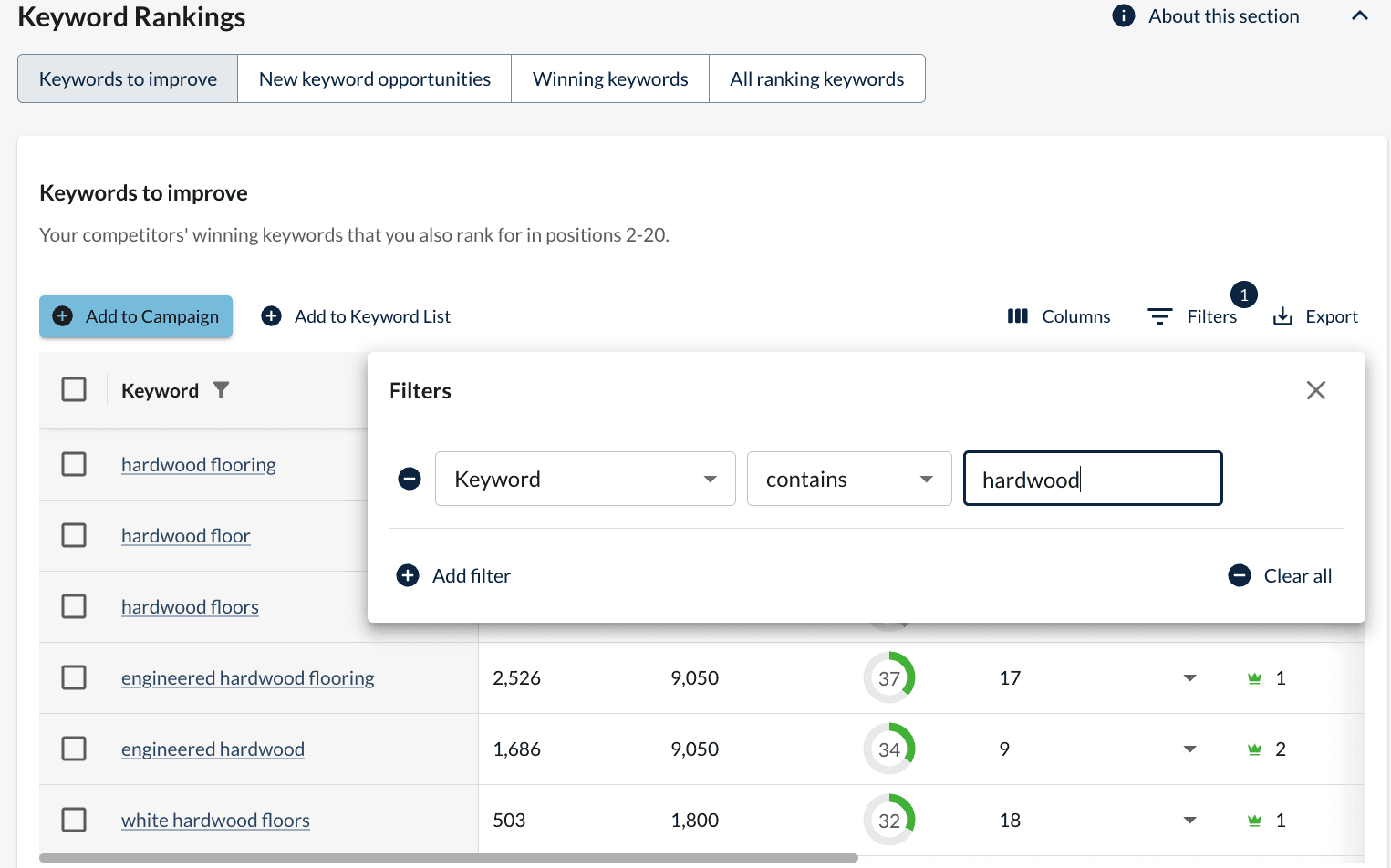
Select keywords and match them to the buyer’s journey
Once you’ve gathered your keyword ideas, you’ll need to narrow them down.
Use these four metrics to decide what to keep:
- Topical relevance: Focus on keywords that align closely with your pillar page.
- Search volume: Target keywords with demand, but don’t ignore zero-volume terms if they support conversions or sales enablement.
- Search intent: Balance your content and don’t fixate on bottom-of-funnel keywords. Cover the entire content funnel to meet users at every stage.
- Keyword Difficulty: Choose keywords you can rank for now. Save harder ones for later, when your topical authority improves.
Next, map each keyword to a stage in the buyer’s journey:
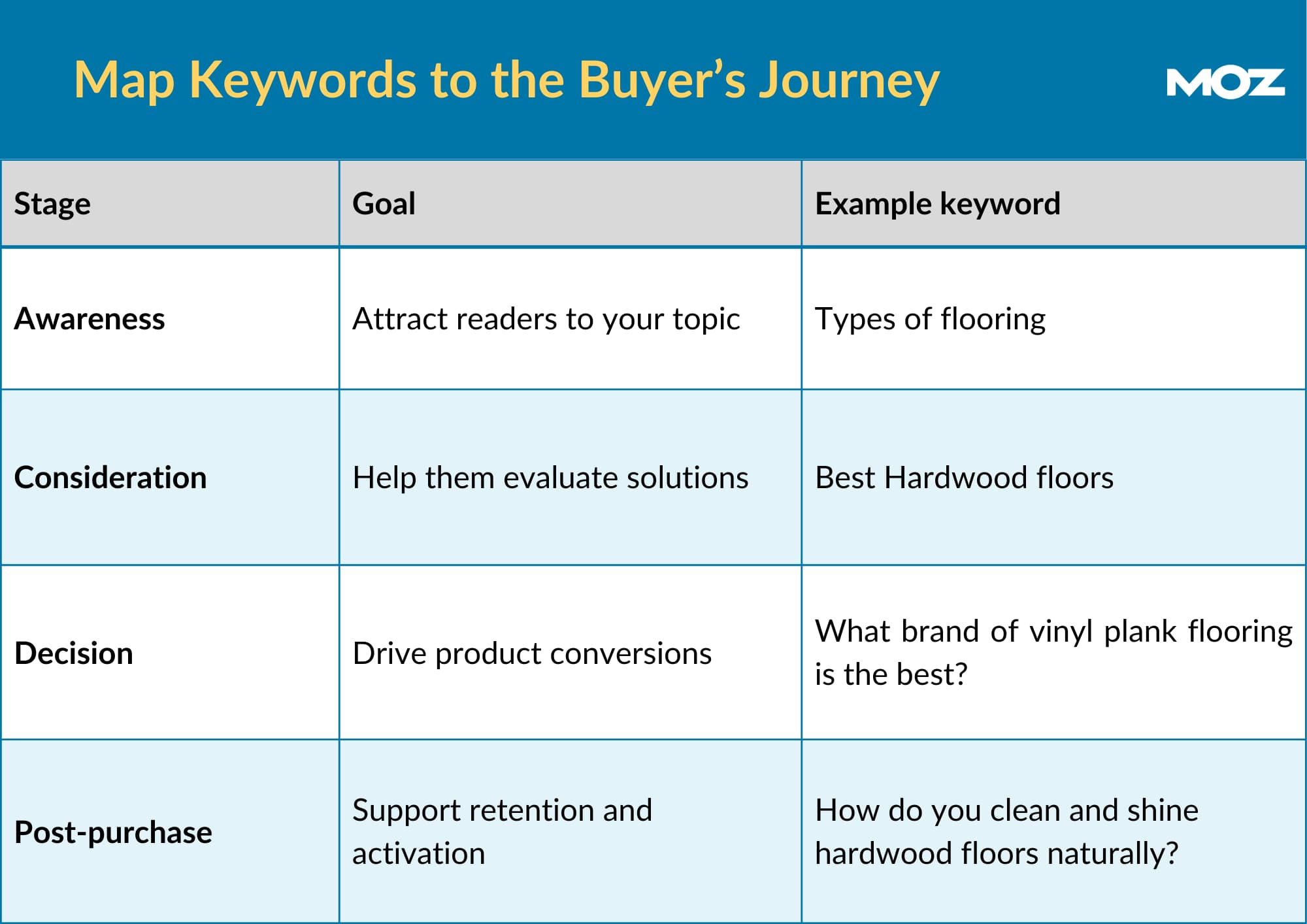
Got siloed keywords everywhere?
Organize your content with Moz Keyword Suggestions by Topics

Create multi-format content
Most teams stop at blog posts, and that’s a big mistake. The brands that own the SERPs, like HubSpot, Monday.com, and Salesforce, build topic clusters beyond the blog. They include webinars, videos, social content, and more.
Diversifying formats helps them show up across every stage of the buyer journey. To do the same, you need an omnichannel content strategy that ranks in search and reaches your target audience wherever they spend time.
Here’s how to build it:
Create pillar pages
Your pillar page should be the most complete resource on the topic. It sets the direction for the topic cluster and becomes the anchor for both search engines and readers.
When writing a pillar page:
- Write in-depth content
- Link to each supporting piece
- Show product workflows where relevant
- Include expert quotes, stats, and credible sources
Support with blog content
Break your pillar into focused subtopics. Each blog post should target a specific keyword or intent and link back to the pillar.
As you write:
- Review top-ranking pages for each subtopic
- Find gaps in their coverage and go deeper
- Use entities naturally to strengthen relevance
- Add product tie-ins that feel helpful, not salesy
- Include visuals like screenshots and embedded videos to increase user engagement
Diversify your content format
Google looks at more than your blog. Off-page signals also shape your authority, so your content should exist across multiple platforms.
Create:
Webinars: Invite internal experts or SMEs to share actionable insights. It’s great for lead gen and Brand Authority.
Short-form videos: Repurpose webinar clips or turn blog posts into quick videos for LinkedIn, YouTube, and Instagram.
Courses or certifications: These work well for broad topics like SEO or email marketing. At Moz, we use courses like 30 Days of SEO to deliver value while building trust.
Social content: Turn blog takeaways into LinkedIn posts, Twitter threads, or carousels that drive awareness and traffic.
Guest posts & third-party mentions: Partner with relevant blogs or publications to earn backlinks and build off-site authority.
Build internal links
Internal links connect your topic cluster strategy. Without them, your content sits in silos and loses authority.
Here’s a simple internal linking structure for your topic cluster:
Link from pillar → cluster
Link from cluster → pillar
If you’ve mapped your cluster using the template, you should already know which pages need to link where. All that’s left is implementation.
I also recommend using the content brief template while outlining. It includes a section for internal linking, so you plan your cluster links before you start writing.
Examples of topic clusters
1.Salesforce’s CRM cluster
When I first learned about topic clusters, I spent a lot of time reviewing Salesforce’s CRM cluster. They rank top of Google for a high-volume keyword and own a massive footprint across related searches.
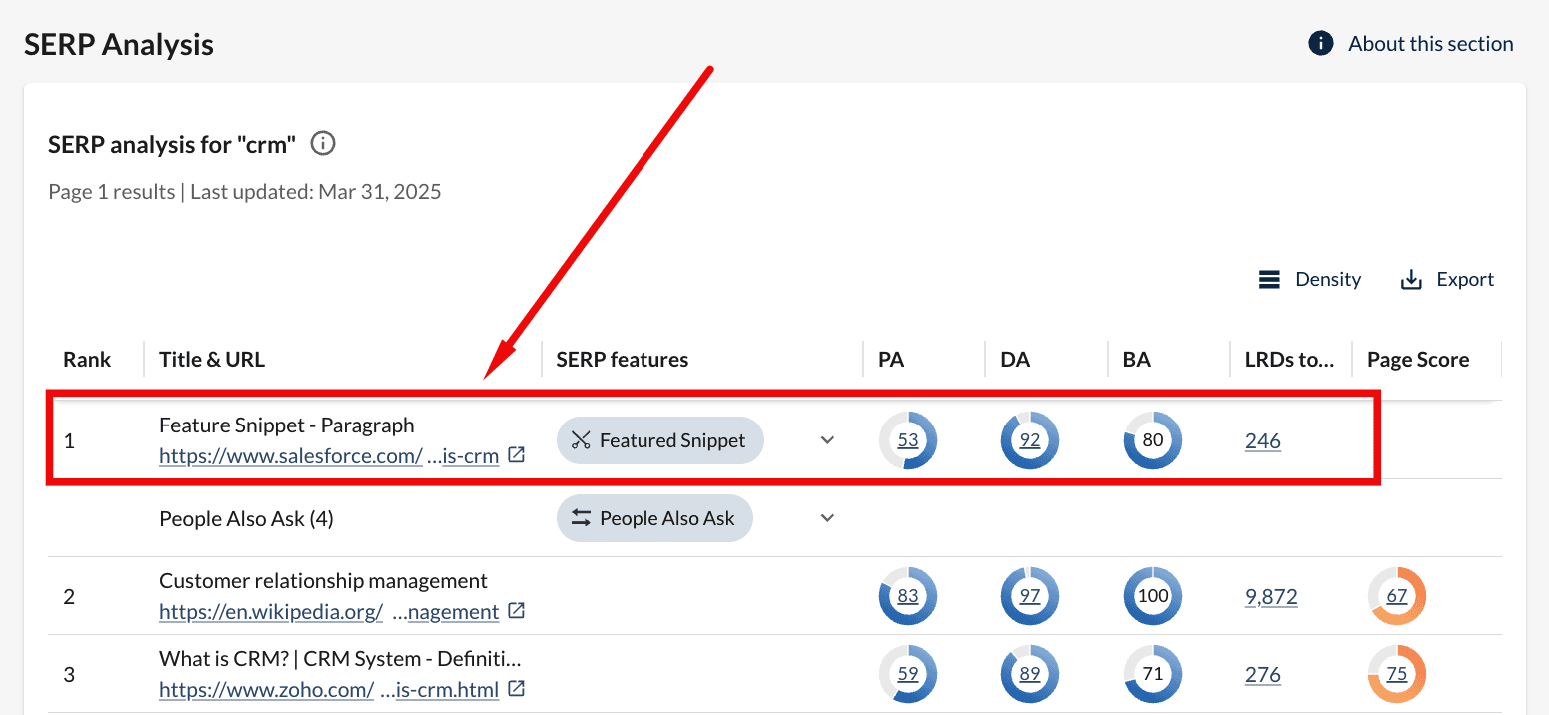
What stood out immediately was how they used entities across the page to help search engines understand the content and build internal links within and across clusters.
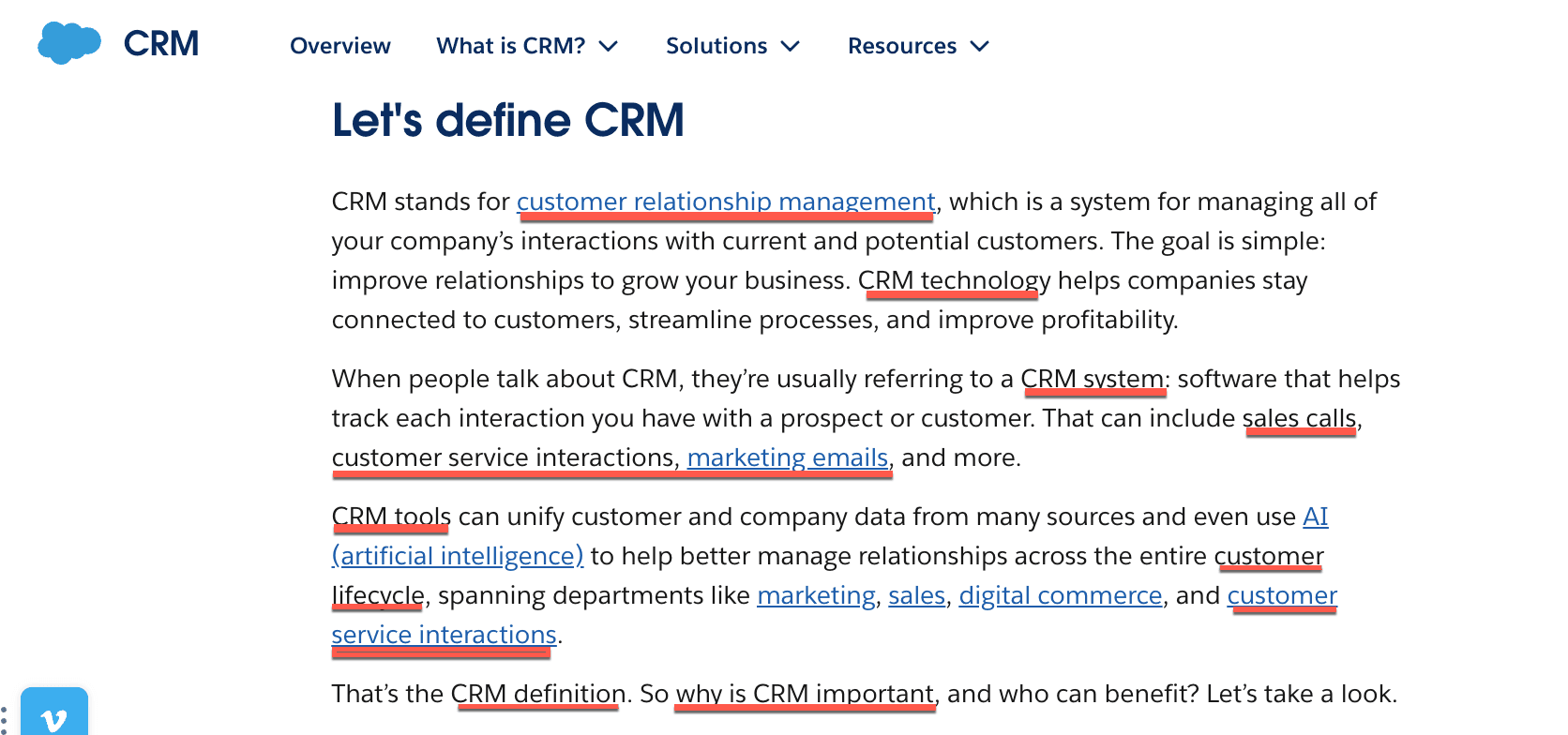
Their CRM pillar page links to articles on related topics like CRM systems, CRM software, and best CRM tools. Further down the page, they include a beginner’s guide to CRM, which doubles as a lead magnet.
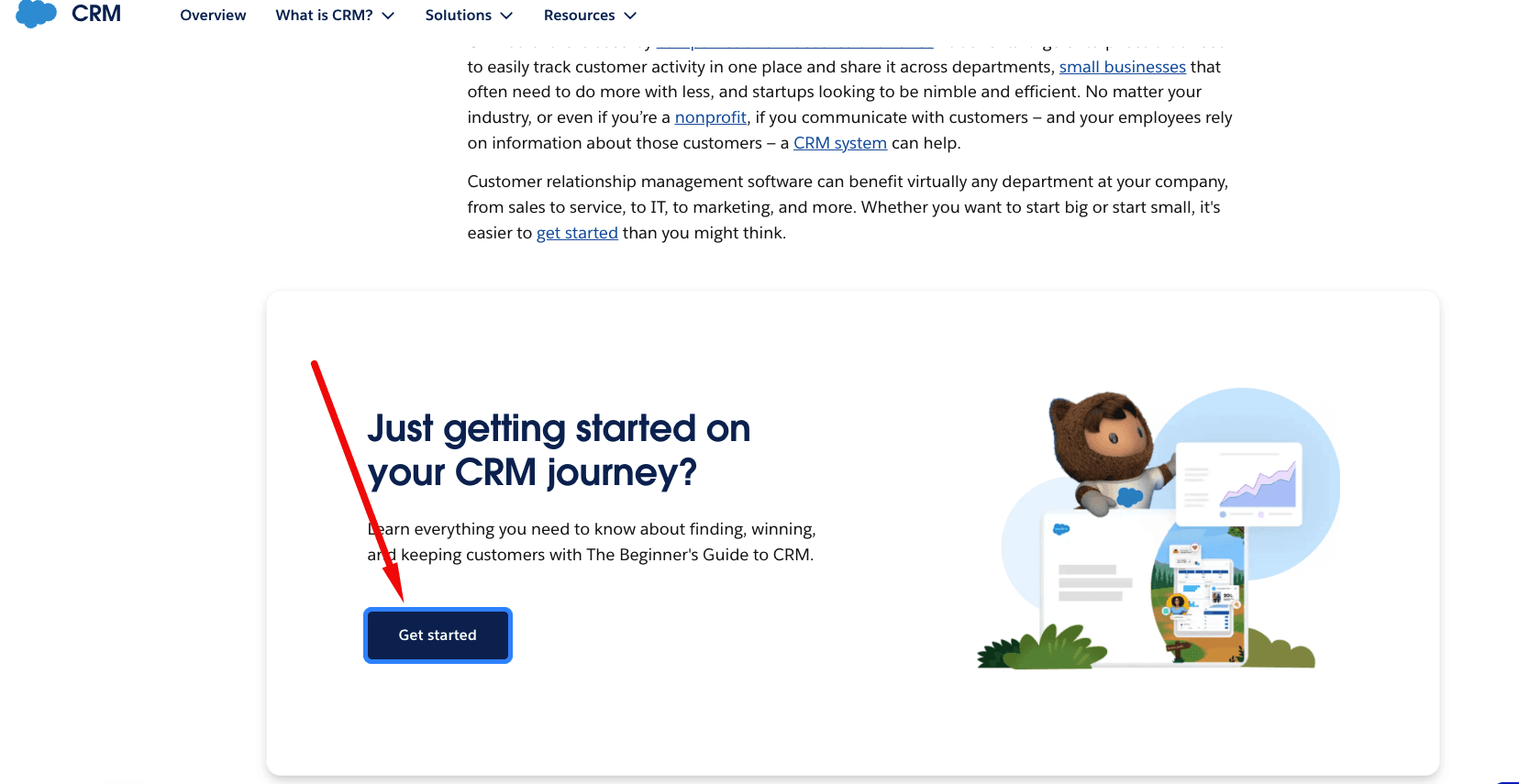
What I appreciate most is their use of diversified formats. This topic cluster includes videos, reports, webinars, and other assets that support different stages of the funnel.
2. HubSpot’s comprehensive inbound marketing cluster
Fun fact: I learned how to build topic clusters through HubSpot’s inbound marketing course. They’ve been setting the standard for years, and their inbound topic cluster is still one of the best examples.
It starts with a resource-dense pillar page that explains the fundamentals of inbound marketing. Right at the top, they link to their free course, which acts as a lead gen asset and logical next step for the reader.
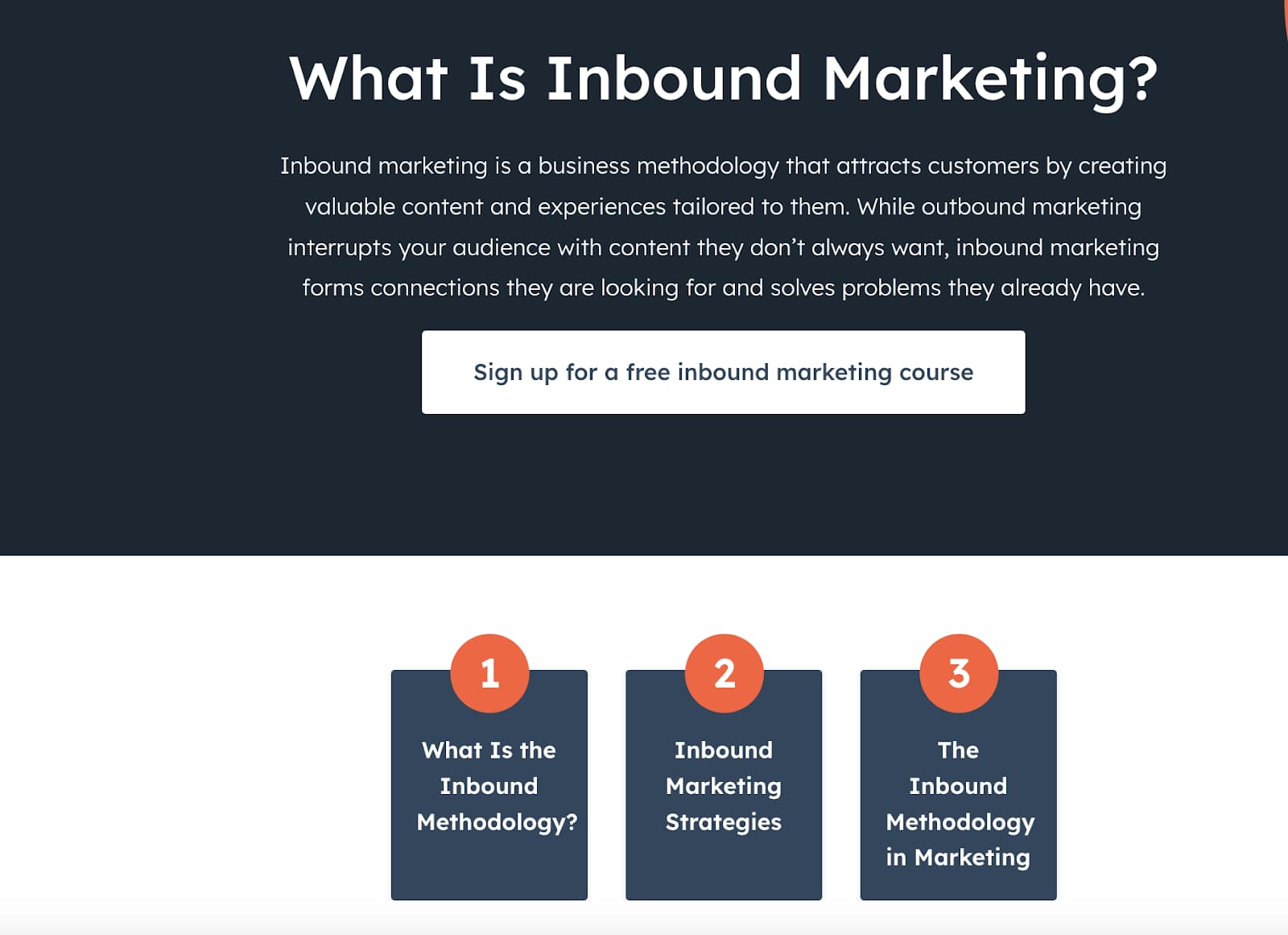
Like Salesforce, HubSpot uses entities throughout the content and relies on internal links to connect the pillar to subtopics.
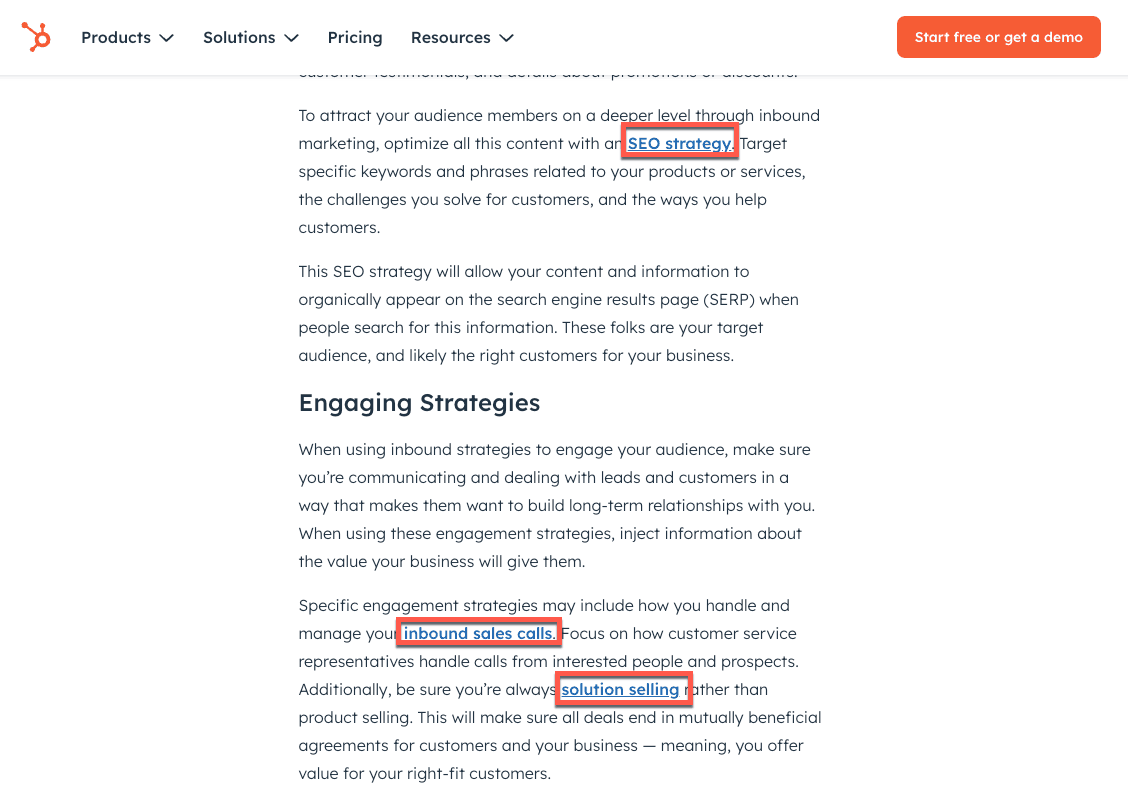
They also link to product pages in a natural way and position their tools as helpful solutions.
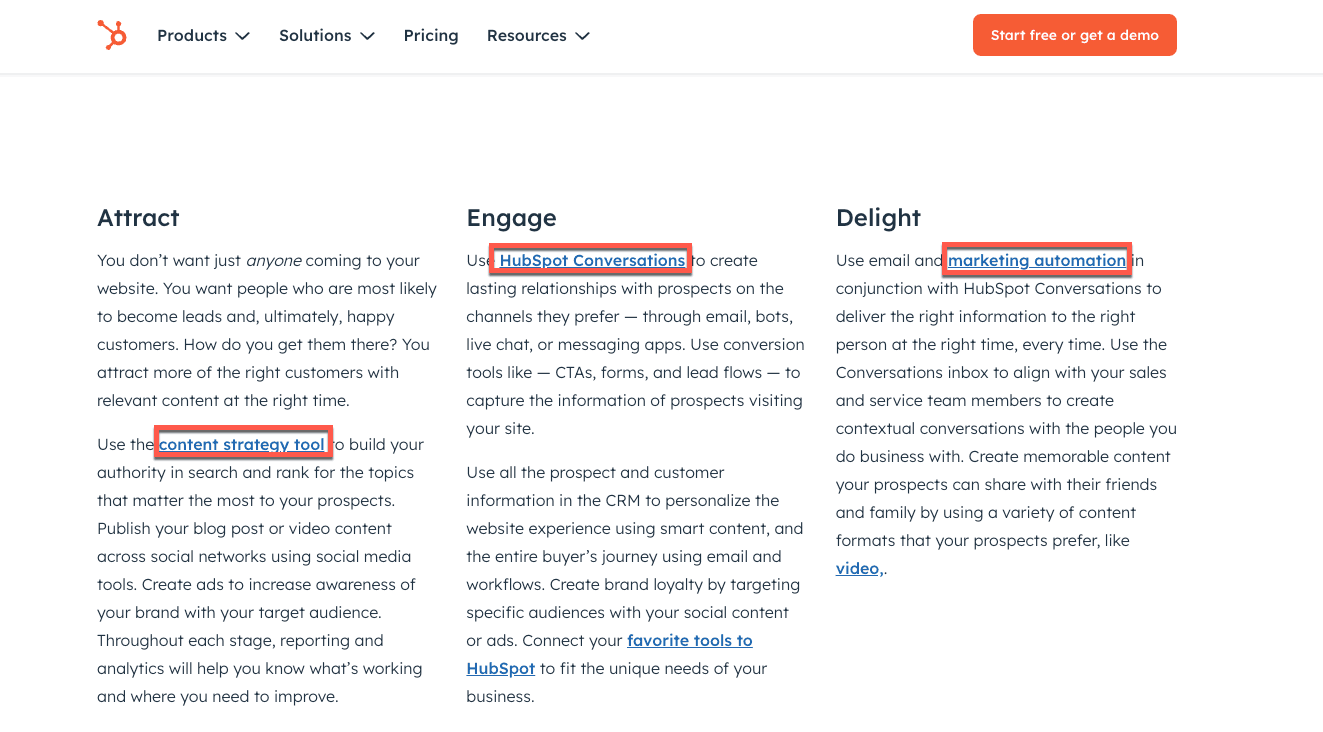
One of the smartest moves they make is linking to their course at both the top and bottom of the page. It’s intentional because that course is a major conversion path.

The key takeaway here is that you shouldn’t rely on blog posts alone. HubSpot uses blog content, courses, videos, and product tie-ins to create a topic cluster that works across formats and channels.
Build your cluster in minutes
with Keyword Suggestions by Topic

Conclusion: Own your topics and improve your search visibility with topic clusters
Topic clusters help you rank higher, improve user experience, and get more value from every piece of content you create.
You don’t need to be HubSpot or Salesforce to make it work. Start with one topic cluster this week and use our Keyword Suggestions by Topic to build it right now.

![What Is Generative Engine Optimization [Tips & Workflows To Do It]](https://cloudz.click/images/blog/banners/What-Is-Generative-Engine-Optimization-Tips-Workflows-To-Do-It-1.png?w=580&h=196&auto=compress%2Cformat&fit=crop&dm=1745607929&s=5e9f8bc064c19ecabcb8b5b64eff324d)

